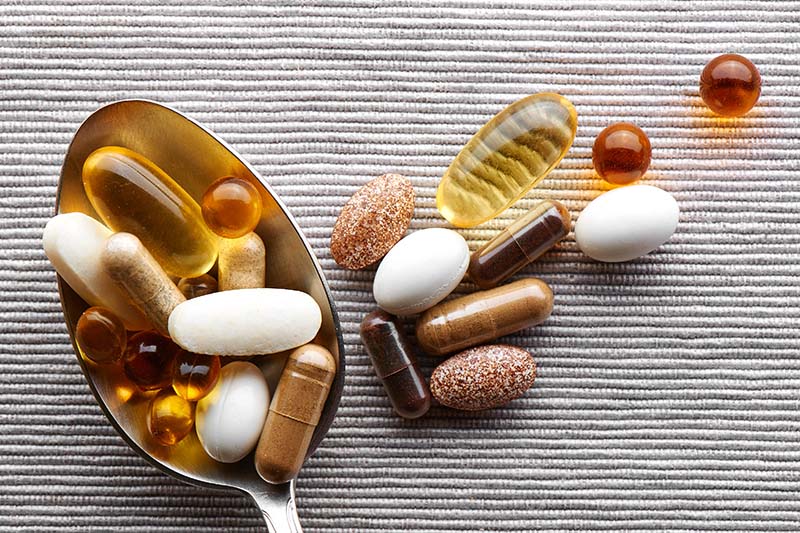
Vitamins and Minerals for Older Adults
Vitamins and minerals are two of the main types of nutrients that your body needs to survive and stay healthy. Find information on some of the essential vitamins recommended for older adults and how to get the recommended amount within your diet.
Vitamins help your body grow and work the way it should. There are 13 essential vitamins — vitamins A, C, D, E, K, and the B vitamins (thiamine, riboflavin, niacin, pantothenic acid, biotin, B6, B12, and folate).
Vitamins have different jobs to help keep the body working properly. Some vitamins help you resist infections and keep your nerves healthy, while others may help your body get energy from food or help your blood clot properly. By following the Dietary Guidelines, you will get enough of most of these vitamins from food.
Like vitamins, minerals also help your body function. Minerals are elements that our bodies need to function that can be found on the earth and in foods. Some minerals, like iodine and fluoride, are only needed in very small quantities. Others, such as calcium, magnesium, and potassium, are needed in larger amounts. As with vitamins, if you eat a varied diet, you will probably get enough of most minerals.
How can I get the vitamins and minerals I need?
It is usually better to get the nutrients you need from food, rather than a pill. That’s because nutrient-dense foods contain other things that are good for you, like fiber.
Most older adults can get all the nutrients they need from foods. But if you aren’t sure, always talk with your doctor or a registered dietitian to find out if you are missing any important vitamins or minerals. Your doctor or dietitian may recommend a vitamin or dietary supplement.
It’s important to be aware that some supplements can have side effects, such as increasing the risk of bleeding after an injury or changing your response to anesthesia during surgery. Supplements can also interact with some medicines in ways that might cause problems. For example, vitamin K can reduce the ability of the common blood thinner warfarin to prevent blood from clotting. If you do need to supplement your diet, your doctor or pharmacist can tell you what supplements and doses are safe for you.
When looking for supplements to buy, you may feel overwhelmed by the number of choices at the pharmacy or grocery store. Look for a supplement that contains the vitamin or mineral you need without a lot of other unnecessary ingredients. Read the label to make sure the dose is not too large. Avoid supplements with megadoses. Too much of some vitamins and minerals can be harmful, and you might be paying for supplements you don’t need. Your doctor or pharmacist can recommend brands that fit your needs.
Here’s a tipDifferent foods in each food group have different nutrients. Picking an assortment within every food group throughout the week will help you get many nutrients. For example, choose seafood instead of meat twice a week. The variety of foods will make your meals more interesting, too. |
Measurements for vitamins and minerals
Vitamins and minerals are measured in a variety of ways. The most common are:
- mg – milligram (a milligram is one thousandth of a gram)
- mcg – microgram (a microgram is one millionth of a gram. 1,000 micrograms is equal to one milligram)
- IU – international unit (the conversion of milligrams and micrograms into IU depends on the type of vitamin or drug)
Recommended sodium intake for older adults
Sodium is another important mineral. In most Americans’ diets, sodium primarily comes from salt (sodium chloride). Whenever you add salt to your food, you're adding sodium. But the Dietary Guidelines shows that most of the sodium we eat doesn’t come from our saltshakers — it’s added to many foods during processing or preparation. We all need some sodium, but too much over time can lead to high blood pressure, which can raise your risk of having a heart attack or stroke.
How much sodium is okay? People 51 and older should reduce their sodium intake to 2,300 mg each day. That is about one teaspoon of salt and includes sodium added during manufacturing or cooking as well as at the table when eating. If you have high blood pressure or prehypertension, limiting sodium intake to 1,500 mg per day, about 2/3 teaspoon of salt, may be helpful. Preparing your own meals at home without using a lot of processed foods or salt will allow you to control how much sodium you get. Try using less salt when cooking, and don’t add salt before you take the first bite. If you make this change slowly, you will get used to the difference in taste. Also look for grocery products marked “low sodium,” “unsalted,” “no salt added,” “sodium free,” or “salt free.” Also check the Nutrition Facts Label to see how much sodium is in a serving.
Eating more fresh vegetables and fruit also helps — they are naturally low in sodium and provide more potassium. Get your sauce and dressing on the side and use only as much as you need for taste.
Key vitamins and minerals for people over age 51
Explore details about the following vitamins and minerals and recommended amounts for older adults:
Vitamin A | Vitamin B1 (Thiamin) | Vitamin B2 (Riboflavin) | Vitamin B3 (Niacin) | Vitamin B6 | Vitamin B12 | Vitamin C | Calcium | Vitamin D | Vitamin E | Folate | Vitamin K | Magnesium | Potassium | Sodium
Vitamin A. Food Sources: Vitamin A can be found in products such as eggs and milk. It can also be found in vegetables and fruits, like carrots and mangoes.
- Men Age 51+: Most men 51 and older should aim for 900 mcg RAE.
- Women Age 51+: Most women 51 and older should aim for 700 mcg RAE each day.
Vitamin B1 (Thiamin). Food Sources: You can find vitamin B1 in meat – especially pork – and fish. It’s also in whole grains and some fortified breads, cereals, and pastas.
- Men Age 51+: Most men 51 and older should aim for 1.2 mg each day.
- Women Age 51+: Most women 51 and older should aim for 1.1 mg each day.
Vitamin B2 (Riboflavin). Food Sources: You can find vitamin B2 in eggs and organ meat, such as liver and kidneys, and lean meat. You can also find it in green vegetables, like asparagus and broccoli.
- Men Age 51+: Most men 51 and older should aim for 1.3 mg each day.
- Women Age 51+: Most women 51 and older should aim for 1.1 mg each day.
Vitamin B3 (Niacin). Food Sources: Vitamin B3 can be found in some types of nuts, legumes, and grains. It can also be found in poultry, beef, and fish.
- Men Age 51+: Most men 51 and older should aim for 16 mg each day.
- Women Age 51+: Most women 51 and older should aim for 14 mg each day.
Vitamin B6. Food Sources: Vitamin B6 is found in a wide variety of foods. The richest sources of vitamin B6 include fish, beef liver, potatoes and other starchy vegetables, and fruit (other than citrus).
- Men Age 51+: Most men 51 and older should aim for 1.7 mg each day.
- Women Age 51+: Most women 51 and older should aim for 1.5 mg each day.
Vitamin B12. Food Sources: You can get this vitamin from meat, fish, poultry, milk, and fortified breakfast cereals. Some people over age 50 have trouble absorbing the vitamin B12 found naturally in foods. They may need to take vitamin B12 supplements and eat foods fortified with this vitamin.
- Men Age 51+: 2.4 mcg every day
- Women Age 51+: 2.4 mcg every day
Vitamin C. Food Sources: Fruits and vegetables are some of the best sources of vitamin C. Citrus fruits, tomatoes, and potatoes can be a large source of vitamin C.
- Men Age 51+: Most men 51 and older should aim for 75 mg each day.
- Women Age 51+: Most women 51 and older should aim for 90 mg each day.
Calcium. Food Sources: Calcium is a mineral that is important for strong bones and teeth, so there are special recommendations for older people who are at risk for bone loss. You can get calcium from milk and other dairy, some forms of tofu, dark-green leafy vegetables, soybeans, canned sardines and salmon with bones, and calcium-fortified foods.
- Men Age 51+: Men age 51-70 need 1,000 mg each day. Men age 71 need 1,200 mg each day. Don’t consume more than 2,000 mg each day.
- Women Age 51+: 1,200 mg each day. Don’t consume more than 2,000 mg each day.
Vitamin D. Food Sources: You can get vitamin D from fatty fish, fish liver oils, fortified milk and milk products, and fortified cereals.
- Men Age 51+: If you are age 51–70, you need at least 15 mcg (600 IU) each day, but not more than 100 mcg (4,000 IU). If you are over age 70, you need at least 20 mcg (800 IU), but not more than 100 mcg (4,000 IU).
- Women Age 51+: If you are age 51–70, you need at least 15 mcg (600 IU) each day, but not more than 100 mcg (4,000 IU). If you are over age 70, you need at least 20 mcg (800 IU), but not more than 100 mcg (4,000 IU).
Vitamin E. Food Sources: Vitamin E can be found in nuts like peanuts and almonds and can be found in vegetable oils, too. It can also be found in green vegetables, like broccoli and spinach.
- Men Age 51+: Most men age 51 and older should aim for 15 mg each day.
- Women Age 51+: Most women age 51 and older should aim for 15 mg each day.
Folate. Food Sources: Folate can be found in vegetables and fruit, such as broccoli, brussel sprouts, spinach, and oranges. It can also be found in nuts, beans, and peas.
- Men Age 51+: Most men age 51 and older should aim for 400 mcg DFE each day.
- Women Age 51+: Most women age 51 and older should aim for 400 mcg DFE each day.
Vitamin K. Food Sources: Vitamin K can be found in many foods including green leafy vegetables, like spinach and kale and in some fruits, such as blueberries and figs. It can also be found in cheese, eggs, and different meats.
- Men Age 51+: Most men 51 and older should aim for 120 mcg each day.
- Women Age 51+: Most women should aim for 90 mcg each day.
Magnesium. Food Sources: This mineral, generally, is found in foods containing dietary fiber, such as green leafy vegetables, whole grains, legumes, and nuts and seeds. Breakfast cereals and other fortified foods often have added magnesium. Magnesium is also present in tap, mineral, or bottled drinking water.
- Men Age 51+: 420 mg each day
- Women Age 51+: 320 mg each day
Potassium. Food Sources: Many different fruits, vegetables, meats, and dairy foods contain potassium. Foods high in potassium include dried apricots, lentils, and potatoes. Adults get a lot of their potassium from milk, coffee, tea, and other nonalcoholic beverages.
- Men Age 51+: Men need 3,400 mg each day.
- Women Age 51+: Most women age 51 and older need 2,600 mg each day
Sodium. Food Sources: Preparing your own meals at home without using a lot of processed foods or salt will allow you to control how much sodium you get.
- Men Age 51+: Men 51 and older should reduce their sodium intake to 2,300 mg each day. That is about 1 teaspoon of salt and includes sodium added during manufacturing or cooking as well as at the table when eating. If you have high blood pressure or prehypertension, limiting sodium intake to 1,500 mg per day, about 2/3 teaspoon of salt, may be helpful.
- Women Age 51+: Women 51 and older should reduce their sodium intake to 2,300 mg each day. That is about 1 teaspoon of salt and includes sodium added during manufacturing or cooking as well as at the table when eating. If you have high blood pressure or prehypertension, limiting sodium intake to 1,500 mg per day, about 2/3 teaspoon of salt, may be helpful.
For more information on vitamins and minerals
Office of Dietary Supplements
National Institutes of Health
301-435-2920 | ods@nih.gov | www.ods.od.nih.gov
National Center for Complementary and Integrative Health
888-644-6226 | 866-464-3615 (TTY) | info@nccih.nih.gov | www.nccih.nih.gov
U.S. Food and Drug Administration
888-463-6332 | druginfo@fda.hhs.gov | www.fda.gov
Dietary Guidelines for Americans
703-305-2881 | DietaryGuidelines@usda.gov | https://www.dietaryguidelines.gov/
Source: National Institute on Aging










